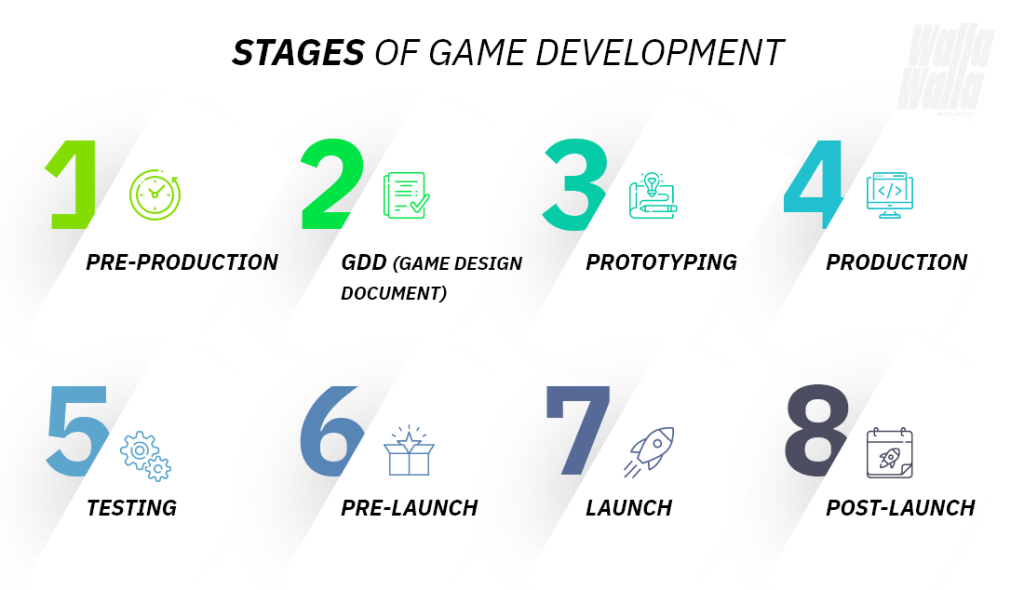Game development is an exciting yet challenging field that has captivated many aspiring creators. From concept to launch, bringing a game to life requires careful planning, skillful execution, and often, a healthy dose of crunch time. One of the most crucial aspects of game development is managing time effectively. Many developers struggle with creating realistic timelines, leading to project delays, scope creep, or even project abandonment. In this blog post, I’ll guide you through creating a realistic and effective timeline for your game development journey.
Understanding Game Development Timeline Basics
If you want more of an understanding of what I’m about to explain, watch this video.
Game development typically involves several distinct stages, each requiring careful planning and execution. These stages include:
- Concept and Design: This initial stage involves brainstorming ideas, defining core mechanics, and sketching out the overall vision of your game.
- Pre-production: During this phase, you refine your concept, create detailed designs, and develop prototypes to test your ideas.
- Production: The bulk of development work happens here, where you implement core features, create assets, and building or using the game engine of your choice.
- Testing and Debugging: This crucial stage involves playtesting, identifying bugs, and fixing issues to ensure a polished final product.
- Launch Preparation: As the launch approaches focus on polishing, optimizing, and preparing marketing materials.
- Launch and Post-launch Support: After release, continue to support your game through updates, patches, and community engagement.
Understanding these stages is essential for creating an accurate timeline. Each stage contributes uniquely to the final product, and their duration can vary significantly depending on the complexity and the coding of your game. For example, a simple 2D puzzle game might have shorter production times compared to a complex 3D open-world RPG.
Factors Affecting Game Development Timelines
Several factors can influence the length of your game development timeline:
- Scope and Complexity: Larger, more complex games naturally require more time. Consider the number of features, levels, and systems you plan to implement. For instance, a game with intricate AI behaviors or massive open worlds will take longer to develop than a simple platformer.
- Team Size and Composition: More developers mean faster progress, but also increased coordination challenges. A small team might work more efficiently but could struggle with certain aspects, while a larger team might face communication hurdles.
- Budget Constraints: Limited resources may force you to prioritize features or use less expensive tools. This could lead to longer development times if you’re waiting for assets or implementing workarounds due to budget limitations.
- Technology and Tools: Choosing between established engines like Unity or Unreal Engine versus custom solutions can significantly impact development speed. While proprietary engines offer powerful features, they often come with learning curves and potential licensing costs.
- External Dependencies: Collaborating with external teams or relying on third-party assets can introduce unforeseen delays. For example, waiting for a commissioned artist or integrating licensed content can slow down your overall timeline.
Creating a Realistic Timeline
To create an accurate timeline:
- Estimate the time for each stage based on your game’s complexity and team size. Research similar projects to get benchmarks for each phase.
- Break down milestones and deliverables into smaller, manageable chunks. This helps in tracking progress and identifying bottlenecks early.
- Account for unexpected challenges by adding buffer time between stages. A common rule of thumb is to allocate 10-20% extra time for unforeseen issues. In my opinion, I would give around 25-30% extra time if the project is especially large.
- Consider using timeline templates or Gantt charts to visualize your project schedule. Tools like Microsoft Project or Trello can help in creating and managing these visual representations.
- Regularly review and adjust your timeline based on actual progress and any changes in scope or requirements. Be prepared to pivot if necessary.
For example, if you estimate three months for production, change your timeframe to four to five months to account for potential setbacks. Remember, having a slightly longer timeline and meeting it early is better than rushing and risking delays.

Managing Scope and Budget Constraints
When faced with limited resources:
- Prioritize features based on importance and feasibility. Focus on core gameplay mechanics first, then expand to secondary features.
- Balance quality with timeline constraints by implementing a “good enough” principle. Sometimes, releasing a game that meets minimum standards is preferable to delaying release indefinitely.
- Consider using open-source tools or free alternatives to save costs. While they might lack some advanced features, they can significantly reduce development time and budget.
- Explore crowdfunding options or partnerships to supplement your budget. Platforms like Kickstarter or Patreon can help raise funds and engage your community early.
- Implement a phased release strategy. Launch with a minimal viable product and gradually add features through post-launch updates.
Tools and Techniques for Timeline Management
Several tools and methodologies can help manage your game development timeline effectively:
- Project Management Software: Utilize tools like Trello, Asana, Jira, or Basecamp to track progress, assign tasks, and set deadlines. These platforms offer various views and integrations to suit different team sizes and preferences.
- Agile Methodologies: Implement iterative development cycles to allow for frequent feedback and adjustments. This approach helps in catching and addressing issues early, reducing the likelihood of major overhauls later in development.
- Regularly update your timeline based on actual progress and any changes in scope or requirements. Celebrate small victories along the way to maintain team morale.
- Conduct regular retrospectives to identify areas for improvement and optimize your workflow.
- Implement automated testing and continuous integration to catch bugs early and streamline the development process.
Mitigating Risks and Staying on Track
To maintain momentum throughout development:
- Identify potential roadblocks early and develop contingency plans. For example, if you’re relying on external assets, have backup plans ready.
- Set realistic goals and celebrate small victories along the way. This helps to keep your team motivated (or just yourself) and provides tangible progress indicators.
- Maintain open communication within your team to address issues promptly. Regular stand-up meetings or daily check-ins can help prevent misunderstandings and bottlenecks.
- Make sure to at the bare minimum check on your progress at least once a week, to keep yourself on task along with seeing if there are any major bugs you need to fix before you go to the next milestone.
- Stay updated with industry trends and best practices. Attend conferences, workshops, or online courses to continuously improve your skills and stay ahead of challenges.
Conclusion
Creating a successful game development timeline requires careful planning, flexibility, and adaptability. By understanding the basic stages of game development, considering various factors that affect timelines, and using appropriate tools and techniques, you can create a realistic schedule.
Remember, game development timelines often face unexpected challenges. The key is to stay flexible and adjust your timeline as needed. By following these guidelines and maintaining a positive attitude, you’ll be well-equipped to bring your game ideas to life successfully.
Additional Resources
For more detailed information on specific aspects of game development timelines, consider exploring these resources:
- Stages of Game Development
- From Idea to Launch: The 7 Stages of Game Development
- The Game Development Process: A Comprehensive Guide
- IMGD 1001: Game Development Timeline
- Stages of Game Development
By applying these insights and best practices, you’ll be better equipped to manage your game development timeline effectively, increasing your chances of success in this hard to learn field.
